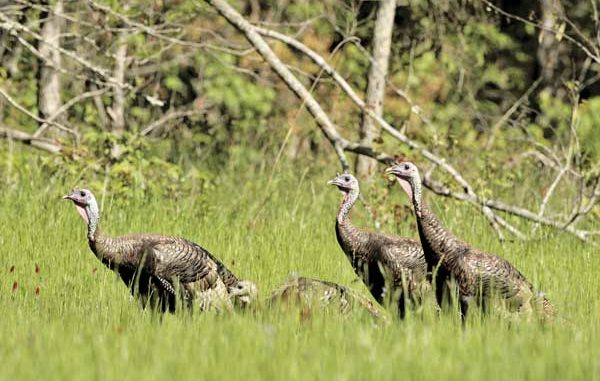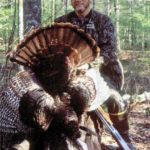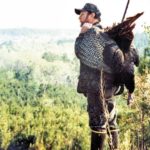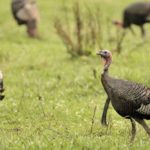
Gobblers can leave you feeling like the King of the Woods or a complete, utter moron.
She pricked my finger, smeared some blood on a slide and took it into the lab for analysis. After reading the findings, the technician glanced nervously at me while whispering behind her hand to a colleague. The doctor was called and in a few moments, I was summoned to his office for a conference.
“Mr. Harris,” the doctor said, “I’m afraid I have some rather disturbing news for you.”
Color drained from my face and my mouth went dry as I waited, dry-mouthed, fingers intertwined, for the horrible news I expected to hear.
“Mr. Harris, I regret to tell you, but all our tests are showing something most unusual,” he said. “It seems that your blood is mixed with another type of blood. It appears to be turkey blood — wild turkey blood.”
Color returned to my face. My fingers relaxed and a big grin replaced the look of fright that had been there only moments before. I jumped up, grabbed the doctor’s hand and pumped it vigorously.
“Thank you, Doc, thank you! You had me scared witless a moment ago. I’ve had turkey blood in my veins since I saw my first strutting gobbler 16 years ago.”
The above scenario may seem a bit silly, but for the serious turkey hunting addict, it’s really not that far off. I bagged my first gobbler in Alabama in 1992, and something happened that cool April morning that has redefined who I am as a hunter. A bit of that gobbler’s blood became mixed with mine that day.
Since my first gobbler flopped at my feet, I have learned much about these marvelous game birds. For the past 16 seasons, I have chased wild turkeys across eight states, and brought 27 of them home with me. I’ve taken birds in enough states to claim a coveted Grand Slam. I’ve learned a lot from each one of these birds, and the many more that outwitted me. Each has taught me something about what to do and what not to do when you’re out in the spring woods chasing them.
Now that turkey season 2008 is on our collective doorstep, I’ll share a few of these lessons I’ve learned, some fulfilling, others painful and many more embarrassing. Let’s call these lessons “The Good, The Bad and The Ugly.”
The Good
There have been a few birds I have bested where things worked out according to the book. I sat, I called, he gobbled, he came in, I bagged him. Easy as pie.
I downed my most impressive gobbler on April 14, 1997, in DeSoto Parish, and the scenario was right out of the turkey hunting videos you see where the bird comes in gobbling and the shot is true.
I was running late that morning as I parked my truck and began a hasty walk in the gathering light down a dusty road toward the bottoms, nearly half a mile away. Songbirds were already trilling from the brush as I hurried along. A crow flapping lazily overhead greeted the morning with a raspy C-C-A-A-A-W-W, and suddenly, a booming gobble shook the woods less than 200 yards away in a stand of pines.
Skidding to a halt, I eased into the pines, listened as the gobbler sounded off once more, and decided where I would set up. The woods were fairly open, so I crawled 20 yards out in front and stuck out a hen decoy. Slinking quietly back to my seat, I listened as the gobbler cranked up, sounding off in response to the call of every crow, owl or pileated woodpecker.
I yelped softly on a slate call, expecting him to roar back, but he was silent, until the next crow called. I switched to my box call, stroking it sweetly.
His response? Total silence, until an owl hooted loudly nearby, and he double-gobbled.
In a moment, I could tell he had flown down, and his gobbles indicated he was headed away from me. The game could have been over quickly, but I wasn’t ready to give up. It was obvious that he wanted to hear something loud and raucous that morning, as indicated by his impulsive response to the crows, owls and woodpeckers.
Having nothing to lose, I decided to go for broke as I slipped a raspy diaphragm call in my mouth and showered down on it with the loudest, sexiest and raspiest cutts, yelps and cackles I could make.
The gobbler turned around and marched back to the decoy, gobbling all the way. I dropped him in his tracks at 20 steps.
The lesson I learned that hunt was the importance of feeling a gobbler’s pulse on a given day. This bird responded only to loud and aggressive sounds that morning. Had I continued my soft calling, no doubt he would still be going the opposite direction.
Four days later on a hunt in Lincoln Parish, my “what do I have to lose” stance brought another gobbler into my lap.
I had hunted this bird on two other occasions without success. On this morning, I slipped along a wood’s road to a pipeline that ran through the property, waiting for daylight and the gobbler to crank up.
When the time seemed right, I “owled,” mimicking the call of a barred owl, and the gobbler responded from his roost in a big pine 200 yards out in front of me. I felt I should find a place to sit along the pipeline rather than try and sneak closer.
The gobbler sounded off regularly, and responded each time I lifted up a soft yelp from my calls. Momentarily, he flew down and began calling from a wood’s road that formed an intersection with the pipeline. His gobbling let me know that he was walking back and forth along the road, out of my sight, and the standoff lasted nearly an hour. I simply could not entice him to come closer.
Had I put away my calls and waited, there is a chance he would have eventually come in to investigate the “hen” he had heard. Patience was not a virtue for me that morning, so I decided I’d press the issue by trying something different.
I dug out my Knight and Hale Duelin’ Hens call, chalked the sound board and then reached for my box call, slipping a rubber band loosely around the box and lid. Using the Duelin’ Hens call as per the instructions, I began staging a knockdown-dragout turkey hen fight. Since I was hunting on private property and I was the only hunter allowed to hunt there, I felt safe enough to use my box call to mimic a jake attempting to gobble.
Alternating between the two calls — fighting hens with an excited jake watching the action — I was preoccupied with the symphony I had created when I saw movement in the pines out front.
Something white was bobbing along quickly, and I identified the white blob as the head of the gobbler that was practically running through the woods to get to the fight. I bagged that gobbler, and I’ve tried this technique numerous times, but it has never worked for me again. On that particular day, though, it was just what the doctor ordered.
On April 3, 1999, I encountered another Lincoln Parish gobbler that provided an experience from which turkey hunting dreams are made.
It was opening day, and I had not been able to scout this particular area prior to the season, but I knew there were turkeys on the property. I parked my truck, and walked toward a pipeline where I hoped to hear a gobbler on the roost somewhere.
Before I got to my listening point, I heard a gobble up the pipeline and across a small clearing to the west. Hurrying along, I found a big cedar at the edge of the clearing, set my hen decoy out in front and nestled down against the tree to see what would happen.
I knew fly-down time was approaching, so I produced a sleepy sounding wake-up yelp on my diaphragm call. He answered immediately, so I hushed. Then the dreaded sound of a hen turkey cackling as she flew off the roost let me know the gobbler had company that morning, and I knew I had to compete.
I let loose with a raucous series of yelps, cackles and cuts, and the gobbler responded enthusiastically. Then, suddenly, there he was. His white head popped over the edge of a ditch, and he came straight to the decoy, strutting every step. I shot him, and was packing him back to my truck before the sun peeked over the horizon.
I was the fortunate benefactor of a gobbler that morning. In the vast majority of cases, he would have flown down and followed the hens roosted around him, but for reasons only known to the gobbler, he ignored them and came on a string to my calling. I don’t know why he did, but I’ll take a gift gobbler any day of the week.
The Bad
If so-called “bad” turkeys challenged you to arm wrestling, they’d beat you every time. Some are accidentally bad, but some are jokesters that like to mess with your mind. Others, I’m convinced, are just flat-out BAD. Period.
If turkeys could laugh, there is no doubt several I’ve encountered have had to cover their beaks with wing tips to stifle chortles and guffaws as they watched me stomp out of the woods, red-faced and kicking every stump I see.
I met a couple of bad turkeys in Alabama. The first one snookered me one morning near Alexander City on my last day to hunt before heading home to Louisiana.
This day started out like gangbusters. I slipped down an old road in an area I hadn’t scouted, but my host assured me turkeys were in the area. As dawn broke and the barred owls cranked up, turkeys started sounding off all around me. Gobblers gobbled and hens yelped and cackled, a wonderful sound to a turkey hunter.
I found a suitable tree to sit against, laid out my calls and began with soft yelps on my slate call. My calls were immediately answered, and I felt good about my prospects.
Soon, birds began flying from the roost, and I got ready, expecting to see a big gobbler come strutting in to my calling. I continued to hear constant turkey talk, but my hopes were dashed when the volume of sound slowly faded as the whole flock headed down toward the bottoms away from me.
I called pleadingly and the gobblers answered, but it was obvious they only wanted to talk to me from a distance; they were following a flock of hens off to the next county.
Fifteen minutes after the gaggle of gobblers and hens had moved on out of hearing, I made a decision to get up, try and loop around to get in front of the flock. It was an ill-advised decision because I stood and took one step — and there he was. A gobbler, no doubt a subdominant bird, had sneaked in silently and for a nano-second, we stared at each other from 30 yards. Then he putted, and was gone before I could react.
I learned a lesson from this gobbler and others that have treated me similarly since then. When you are conversing with a gobbler and things grow quiet, stay put and remain alert. When you are sure no gobbler is coming in, stay put another 15 minutes. Younger gobblers that have had their rear ends whipped by the boss may try and sneak in for a peek at the “hen” they heard, but they’ll almost always come in without a sound.
Another bad gobbler has whipped me soundly for the past three seasons. I’m convinced this Lincoln Parish monarch is a lot smarter than I am.
I call this old bird “Sleep Around Sam” because I never know where he is going to be roosted.
Last season, I got my hands on a device that I felt might finally do the trick on old Sam. Knight and Hale sent me a decoy for testing. This particular decoy goes by the name Pretty Boy, and it is the exact replica of a mature strutting gobbler; I even added a real gobbler fan for more realism.
I got to my blind in a pasture long before daylight, set out Pretty Boy and his submissive partner, Pretty Girl, so that when Sam entered the pasture, as he had done the past two days, he would spot the interloper and hopefully come dashing in, spoiling for a fight.
My plan came very close to working. I heard Sam gobbling from his roost, proceeded to answer him and momentarily, I made out his form as he stood on a terrace in the pasture, 300 yards away.
No one else was hunting the property, so it was safe to mix in gobbles from my gobble tube with hen yelps on a diaphragm. On the previous two hunts, Sam would stop and answer my calling, but then walk off like he had no interest in the hen I was trying to mimic.
On this morning, however, the sight of a big gobbler hovering over a submissive hen was too much for him to take, and I watched Sam march across the pasture, stopping on a knoll 60 yards away to size up the scene.
This was a beautiful morning to be in the turkey woods, with one exception. There was not a whisper of wind, and Pretty Boy just stood there dumbly without moving so much as a single feather. Sam studied the set-up for a moment, gobbled lustily, and then walked away. If I could have read his mind, he was probably thinking, “It’s not worth the effort; I could whip that gobbler with one wing tied behind my back.”
I’m not sure what lesson I learned that day, but you can be sure that before I step into Sam’s lair again, a fishing line will be attached to Pretty Boy to make him move. I believe that if the decoy would have twitched just a bit, Sam would have come on in.
The Ugly
When I consider the “ugly,” I take into account those days I hunted when things shouldn’t have turned out successful for a variety of reasons but somehow they did.
The first mature gobbler I called in by myself is a good example. On March 31, 1994, I was hunting with friends in Caldwell Parish on International Paper Company land. Late in the afternoon the day of our arrival, our host dropped us off along good listening points on the property to see if we could “roost” a gobbler to hunt the following morning.
I was fortunate because as the sun began to set, I heard the heavy FWOOP-FWOOP-FWOOP of a gobbler’s wings as he flew up to roost, confirming his gender a moment later when he gobbled.
Something happened overnight that threatened to spoil my hunt: I developed a cold and a serious case of laryngitis. I was unable to croak out a sound the next morning.
One of the hosts came to my rescue after he dropped me off for the morning hunt. As daybreak was approaching, he “owled” for me, since I couldn’t make a sound.
The gobbler roared back, I sneaked in, stuck out a decoy and called the bird in and shot him. Since this was the first adult gobbler I had ever called in myself, I jumped up, pumped my fist and yelled, but no sound came out.
I didn’t care. The only problem was when I got back to camp, I didn’t have the voice to tell the exciting story of my conquest of this big gobbler.
I encountered another “bad bird” situation on a hunt in Alabama on March 20, 1996. As I drove from my home to meet a friend in Alabama, the weather reports were anything but good. Cold weather with the chance of snow greeted me when I pulled into the camp around noon.
My host dropped me off in a spot with a green field adjacent to a swampy area. My only hope of bagging a gobbler on this bitterly cold day was to waylay one coming to the green field.
Actually, it worked the other way. As I peeked through the briars in late afternoon, I saw a hen and two gobblers already feeding in the field, so I backed off a dim trail that led from the field to the swamp. As daylight began fading, the birds started meandering my way, heading for the swamp to fly up for the night. As snow flakes drifted down and a cold wind blew, I ambushed the lead gobbler. I would much prefer calling a gobbler in, but under those conditions, I took the best option available.
If you hunt turkeys long enough, you’ll run into all sorts of situations — some that will leave you pumping your fist with glee, others scratching your head in bewilderment or kicking stumps and uttering epithets. In the world of the wild turkey, some birds are “good,” some are “bad” and some are just plain “ugly.”






